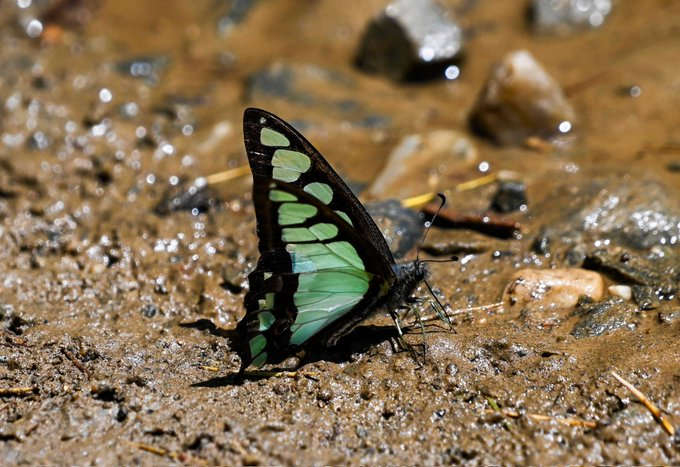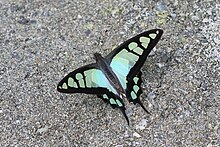Today's butterfly is Graphium cloanthus, the Glassy Bluebottle. "Bluebottle" was the traditional English name for a kind of fly with patches of color like old blue glass bottles and jars. Glass bottles and jars were already available in other colors, including whitish "milk" glass, so when Australians and New Zealanders applied "bluebottle" to a family of butterflies they included those colors too.
Cloanthus was the name of a character in ancient literature. In the Aeneid, he was a defeated Trojan who moved to Italy and became the ancestor of the Cluentius family. Early naturalists had a tradition of naming Swallowtails after characters in literature.
Found in several parts of southern Asia, this butterfly is common and popular. Its likeness appears on shirts, posters, etc., and has even been used on money. Efforts have been made to map its DNA:
.
Apart from that paper, Google pulls up little scientific material about this species. What comes up is an almost even mix of pretty pictures of adult butterflies, merchandise decorated with such pictures, and actual dead bodies offered for sale. An additional reason never to pay for any part of a dead butterfly is that, if no one would pay for dead bodies, searches for information about butterflies would be much more pleasant.
"Swallow tails" vary in length. Wingspan can be four inches or just over. Males and females look very much alike. Head and thorax segments are covered in soft mouse-gray fur. Abdominal segments have black and white lengthwise stripes. Males have scent folds. The predominant color of the wings is iridescent and can look blue, aquamarine, white, green, or yellow in different lights.
Slight differences in color markings are classified as subspecies clymenus and sumattranus, sometimes kuge.
The butterflies are primarily pollinators, often seen on lantana and hibiscus flowers. They sip water from shallow puddles, sometimes in groups. While some Graphiums don't seem to care who shares a puddle and some like to be the only one of their sex and species in the neighborhood, cloanthus seem to prefer to flock together with other cloanthus.
Caterpillars are typically well camouflaged with leaf-green skins and a humpbacked, tapered body shape. They eat the leaves of vines in the genus Aristolochia, species acuminata, foveolata, indica, ringens, and tagala. They have also been found on camphor trees.
Photo by Tony2148. Descriptions of juvenile cloanthus sound almost identical to descriptions of juvenile choredon except that the final tail segments of choredon caterpillars are a forked pair of little prickly points, while those of cloanthus are closer together and look like a single point. Graphium caterpillars are not venomous but some of them are prickly, like cucumbers. The humped back has a horizontal crossbar between two little prickles. The osmeterium actually appears, when it does, a couple of segments ahead of the crossbar but the crossbar becomes even more prominent, forming the points at the top of the chrysalis, in the pupal stage.
The life cycle of such a popular butterfly has to have been documented somewhere, but it doesn't seem to have been digitized.



No comments:
Post a Comment